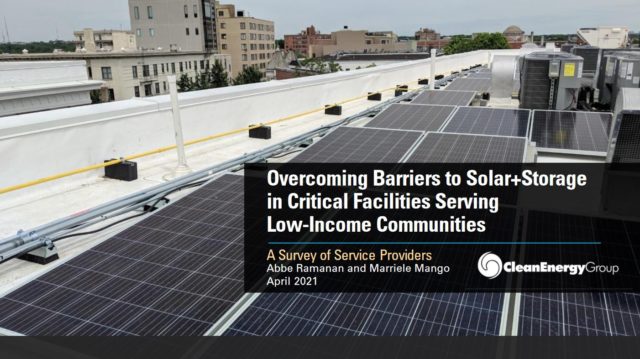Overcoming Barriers to Solar+Storage in Critical Facilities Serving Low-Income Communities: A Survey of Service Providers
Abbe Ramanan, Marriele Mango | Clean Energy States Alliance & Clean Energy Group
Critical facilities serving low-income communities could benefit greatly from the cost savings and energy resilience of solar combined with energy storage. However, this sector faces numerous barriers to solar+storage deployment, and market penetration remains low.
As part of CESA’s Scaling Up Solar for Under-Resourced Communities Project, Clean Energy Group conducted a survey of municipalities, community organizations, affordable housing developers, and technical service providers who have been involved in developing solar+storage projects. This report summarizes the results of the survey and suggests actions to bring the benefits of solar+storage to the people who need it most.
Although the report overviews responses from organizations across multiple sectors, focus is given to comparing the barriers to solar+storage development experienced by affordable housing developers and community service providers. Based on the results of the survey, report authors make five key recommendations:
- Increase Awareness of Battery Storage: Freely available educational materials can be valuable in addressing the resilient power learning curve faced by organizations when considering backup power options.
- Create Opportunities for Capacity Building: Programs that support internal capacity building can uplift community organizations struggling to develop resilient power resources due to limited staff time and resources.
- Provide Technical Assistance Support: Upfront technical assistance from a trusted third-party can provide a valuable first step in the resilient power process by framing the economic and resiliency potential of a solar+storage project.
- Develop Innovative Incentive and Finance Options: Incentive programs that reduce upfront costs and monetize the grid services that batteries provide can support project finance by improving system economics.
- Establish a Monetary Value for Resilience: Assigning a monetary value to resilience can improve the economic calculus for organizations weighing the economic benefits of solar+storage.
This report builds on the findings of a January 2021 report, Overcoming Barriers to Solar and Storage in Affordable Housing, which explores market barriers and opportunities for expanding solar+storage the affordable housing sector.
This material is based upon work supported by the U.S. Department of Energy, Office of Energy Efficiency and Renewable Energy (EERE), specifically the Solar Energy Technologies Office.
Associated Project(s):
Resource Details:
Date: April 21, 2021
Type: Report
Topic(s): Low- and Moderate-Income Clean Energy, Solar PV

